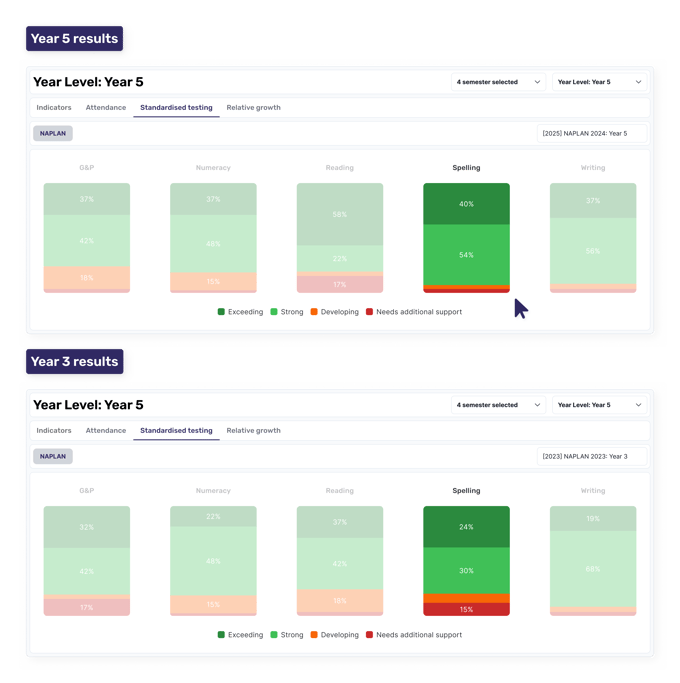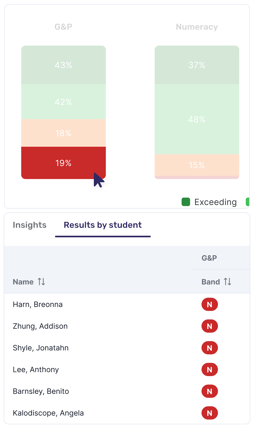As educators, reflecting on assessment data, like NAPLAN results, provides a valuable opportunity to enhance teaching strategies and improve student outcomes. A comprehensive analysis of these results can reveal trends, strengths, challenges, and opportunities for curriculum alignment and growth. Here’s how schools can effectively utilise the Intellischool Analytics displays of NAPLAN data to drive educational success:
Understanding Cohort Trends
Analysing NAPLAN results at the cohort level can really help identify patterns and trends in students' performance. Taking a closer look beyond just the reported proficiency levels allows teachers to gain a deeper understanding of how these results align with classroom goals and other assessments. Often, you'll notice some skills or subjects shining as strengths, while others highlight areas where students could benefit from a little extra support and targeted assistance.
Curriculum Alignment
A critical reflection point is assessing how well the curriculum aligns with NAPLAN skills. Identifying gaps allows educators to refine instructional strategies and better differentiate instruction to cater to diverse learners. This alignment ensures that teaching methods support essential skill development needed for NAPLAN success.
Intellischool Analytics pulls out the top 6 skills students are ready to learn next based on their Zone of Proximal Development (ZPD) question analysis. These skills are listed in the 'Insights' under the NAPLAN stacked bar charts and can be filtered for specific proficiencies.
For more info on how we calculate ZPD - click here.

Comparative and Growth Analysis
Comparing current results to previous years can highlight significant changes or trends in performance. This comparative analysis offers insights into the effectiveness of past interventions and can guide future initiatives.
Now that each cohort has two instances of ‘new’ NAPLAN scaling, it’s worth considering how distribution across proficiencies may have shifted across tests for the same cohort of students.
- Was this shift expected/unexpected?
- How does it compare to any other shift(s) between two tests for past cohorts?

Celebrating and Enhancing Growth
Recognising areas where students excel helps educators celebrate achievements and share successful strategies. At the same time, understanding what might be holding students back can inspire creative solutions to help them progress even faster.
When focusing solely on NAPLAN results, or comparing them with other assessments, it's useful to ask:
- Were most students showing growth or regression?
- How did this change when looking exclusively at NAPLAN or specific learning areas?
- And what differences emerged across various testing years? These insights can guide more targeted and effective support for every learner.
Individual and Group Focus
Exploring how individuals and groups perform helps us identify where learning needs and differences exist. Clicking the stacked bar chart, filter to show a list of students in each proficiency level, and consider:

- Did we expect to see these students achieve at this level?
- How did their performance compare to other domains?
- Have these students previously achieved at a similar level, or have they shown growth/regression?
- For students who fell into ‘Needs additional support’, do we already have formal learning interventions in place?
- Can we consult with support staff to explore intervention options, including NCCD funding?
Go one step further: click a learner's name to jump to their individual Learner Standardised Testing dashboard and unpack their individual results longitudinally in even more detail.
Action and Prioritisation
These reflections are a wonderful way for educators to focus on what truly matters for the upcoming term or year. They help in setting clear, achievable, and meaningful goals that inspire progress within a specific timeframe.
Conclusion
Regularly reflecting and planning actions based on NAPLAN data is essential for ongoing school growth. When educators carefully analyse results, they can make thoughtful decisions that improve teaching methods and support better student learning. Embracing this reflective mindset will help create a fairer and more effective learning environment for everyone.